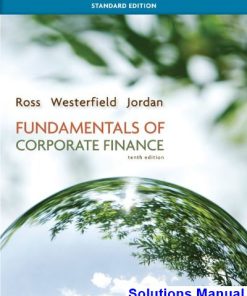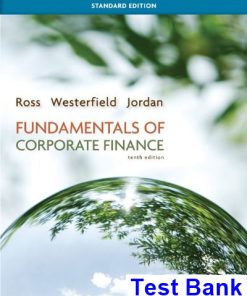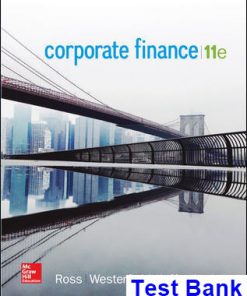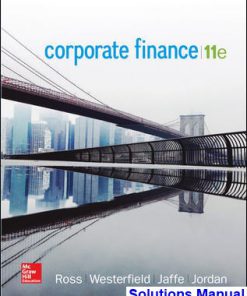Corporate Finance 10th Edition Ross Test Bank
You may also like
-
$26.50
$50.00 -
$26.50
$50.00
Corporate Finance 10th Edition Ross Test Bank

Product details:
- ISBN-10 : 0077511387
- ISBN-13 : 978-0077511388
- Author: Randolph W.Westerfield
Corporate Finance, by Ross, Westerfield, and Jaffe emphasizes the modern fundamentals of the theory of finance, while providing contemporary examples to make the theory come to life. The authors aim to present corporate finance as the working of a small number of integrated and powerful intuitions, rather than a collection of unrelated topics. They develop the central concepts of modern finance: arbitrage, net present value, efficient markets, agency theory, options, and the trade-off between risk and return, and use them to explain corporate finance with a balance of theory and application. The Tenth Edition includes many exciting new research findings as well as an enhanced Connect Finance, now with even more student learning resources.
Connect is the only integrated learning system that empowers students by continuously adapting to deliver precisely what they need, when they need it, and how they need it, so that your class time is more engaging and effective.
Table contents:
Chapter 1 Introduction to Corporate Finance 2 Executive Summary 2 1.1 What Is Corporate Finance? 3 Generally Accepted Accounting Principles 25 Noncash Items 25 Time and Costs 25 2.3 Net Working Capital 26 2.4 Financial Cash Flow 26 2.5 The Accounting Statement of Cash Flows 29 The Balance-Sheet Model of the Firm 3 Capital Structure 4 The Financial Manager 5 1.2 Corporate Securities as Contingent Claims on Total Firm Value Cash Flow from Operating Activities 29 Cash Flow from Investing Activities 30 Cash Flow from Financing Activities 30 2.6 Summary and Conclusions 31 Appendix 2A Financial Statement Analysis 34 9Appendix 2B U.S. Federal Tax Rates 42 1.3 The Corporate Firm 10 The Sole Proprietorship 10 The Partnership 10 Chapter 3 Financial Planning and Growth The Corporation 11 Case Study: Making the Decision to Become a Corporation:The Case of PLM International, Inc. 12 44 Executive Summary 44 3.1 What Is Financial Planning? 44 3.2 A Financial-Planning Model: The Ingredients 45 1.4 Goals of the Corporate Firm 14 Agency Costs and the Set-of-Contracts Perspective 14 Managerial Goals 15 Separation of Ownership and Control 15 Do Shareholders Control Managerial Behavior? 16 1.5 Financial Markets 17 3.3 The Percentage Sales Method 47 The Income Statement 48 The Balance Sheet 49 3.4 What Determines Growth? 51 3.5 Some Caveats of Financial-Planning Models 54 The Primary Market: New Issues 17 3.6 Summary and Conclusions 55 Secondary Markets 18 Exchange Trading of Listed Stocks 18 Listing 18 1.6 Outline of the Text 19 Chapter 2 Accounting Statements and Cash Flow 21 Executive Summary 21 2.1 The Balance Sheet 21 Pa r t II Value and Capital Budgeting 59 Chapter 4 Net Present Value 60 Executive Summary 60 4.1 The One-Period Case 60 The Dividend Growth Model 123 The NPVGO Model 123 Summation 125 5.8 Price-Earnings Ratio 125 4.2 The Multiperiod Case 63 Future Value and Compounding 63 The Power of Compounding: A Digression 67 Present Value and Discounting 68 The Algebraic Formula 71 5.9 Stock Market Reporting 127 4.3 Compounding Periods 72 Distinction between Stated Annual Interest Rate and Effective Annual Interest Rate 73 Compounding over Many Years 73 Continuous Compounding (Advanced) 74 4.4 Simplifications 5.10 Summary and Conclusions 128 Appendix 5A The Term Structure of Interest Rates, Spot Rates, and Yield to Maturity 134 Chapter 6 Some Alternative Investment Rules 144 Executive Summary 144 6.1 Why Use Net Present Value? 144 75 Perpetuity 75 Growing Perpetuity 77 Annuity 79 Growing Annuity 83 Case Study: Making the Decision to Convert Lottery Prize Winnings:The Case of the Singer Asset Finance Company 85 4.5 What Is a Firm Worth? 86 6.2 The Payback Period Method 146 Defining the Rule 146 Problems with the Payback Method 147 Managerial Perspective 148 Summary of Payback 148 4.6 Summary and Conclusions 87 6.3 The Discounted Payback Period Method 149 Appendix 4A Net Present Value: First Principles of Finance 94 Chapter 5 How to Value Bonds and Stocks 106 Executive Summary 106 5.1 Definition and Example of a Bond 106 6.4 The Average Accounting Return Method 149 Defining the Rule 149 Analyzing the Average Accounting Return Method 151 6.5 The Internal Rate of Return 152 6.6 Problems with the IRR Approach 154 Definition of Independent and Mutually Exclusive Projects 154 Two General Problems Affecting Both Independent and Mutually Exclusive Projects 154 Problems Specific to Mutually Exclusive Projects 159 Redeeming Qualities of IRR 163 A Test 163 6.7 The Profitability Index 5.2 How to Value Bonds 106 Pure Discount Bonds 106 Level-Coupon Bonds 107 Consols 109 5.3 Bond Concepts 110164 Interest Rates and Bond Prices 110 Yield to Maturity 110 Bond Market Reporting 111 Calculation of Profitability Index 164 6.8 The Practice of Capital Budgeting 166 5.4 The Present Value of Common Stocks 112 6.9 Summary and Conclusions 168 Dividends versus Capital Gains 112 Valuation of Different Types of Stocks 113 5.5 Estimates of Parameters in the Dividend-Discount Model 116 Where Does g Come From? Chapter 7 Net Present Value and Capital Budgeting 178 Where Does r Come From? 118 116Executive Summary 178 7.1 Incremental Cash Flows 178 Cash Flows?Not Accounting Income 178 Sunk Costs 179 Opportunity Costs 179 A Healthy Sense of Skepticism 118 5.6 Growth Opportunities 119 Growth in Earnings and Dividends versus Growth Opportunities 121 Dividends or Earnings:Which to Discount? 122 The No-Dividend Firm 122 5.7 The Dividend-Growth Model and the NPVGO Model (Advanced) 123 Side Effects 179 Allocated Costs 180 7.2 The Baldwin Company:An Example 180 An Analysis of the Project 182 Which Set of Books? 184 A Note on Net Working Capital 185 Interest Expense 186 7.3 The Boeing 777: A Real-World Example 186 9.6 Summary and Conclusions 249 Appendix 9A The Historical Market Risk Premium: The Very Long Run 253 7.4 Inflation and Capital Budgeting 189 Chapter 10 Return and Risk: The Capital-Asset-Pricing Model (CAPM) 255 Interest Rates and Inflation 189 Cash Flow and Inflation 191 Discounting: Nominal or Real? 191 7.5 Investments of Unequal Lives:The Equivalent Annual Cost Method 193 The General Decision to Replace (Advanced) 195 Executive Summary 255 10.1 Individual Securities 255 10.2 Expected Return,Variance, and Covariance 256 7.6 Summary and Conclusions 197 Expected Return and Variance 256 Covariance and Correlation 258 20610.3 The Return and Risk for Portfolios 261 Minicases: Goodweek Tires, Inc. I. Q. Inc. 207 The Example of Supertech and Slowpoke 261 Jimmy?s Hot Dog Stand 208 Appendix 7A Depreciation 209 The Expected Return on a Portfolio 261 Variance and Standard Deviation of a Portfolio 262 10.4 The Efficient Set for Two Assets 265 Chapter 8 Risk Analysis, Real Options, and Capital Budgeting 211 10.5 The Efficient Set for Many Securities 270 Variance and Standard Deviation in a Portfolio of Many Assets 271 10.6 Diversification:An Example 272 Executive Summary 211 8.1 Decision Trees Risk and the Sensible Investor 275 21110.7 Riskless Borrowing and Lending 276 8.2 Sensitivity Analysis, Scenario Analysis, and Break-Even Analysis 213 Sensitivity Analysis and Scenario Analysis 214 Break-Even Analysis 216 8.3 Monte Carlo Simulation 219 The Optimal Portfolio 278 10.8 Market Equilibrium 280 Definition of the Market-Equilibrium Portfolio 280 Definition of Risk When Investors Hold the Market Portfolio 281 8.4 Options 223 The Option to Expand 223 The Option to Abandon 224 Timing Options 226 8.5 Summary and Conclusions 227 The Formula for Beta 283 A Test 283 10.9 Relationship between Risk and Expected Return (CAPM) 284 Expected Return on Market 284 Expected Return on Individual Security 284 10.10 Summary and Conclusions 287 Pa r t III Risk 233 Chapter 9 Capital Market Theory: An Overview 234 Executive Summary 234 9.1 Returns 235 Appendix 10A Is Beta Dead? 295 Chapter 11 An Alternative View of Risk and Return: The Arbitrage Pricing Theory 297 Dollar Returns 235 Percentage Returns 237 9.2 Holding-Period Returns 239 Executive Summary 297 11.1 Factor Models:Announcements, Surprises, and Expected Returns 298 11.2 Risk: Systematic and Unsystematic 299 9.3 Return Statistics 244 11.3 Systematic Risk and Betas 300 11.4 Portfolios and Factor Models 303 9.4 Average Stock Returns and Risk-Free Returns 246 9.5 Risk Statistics 247 Portfolios and Diversification 305 11.5 Betas and Expected Returns 307 Variance 247 Normal Distribution and Its Implications for Standard Deviation 248 The Linear Relationship 307 The Market Portfolio and the Single Factor 309 11.6 The Capital-Asset-Pricing Model and the Arbitrage Pricing Theory 310 13.2 A Description of Efficient Capital Markets 351 Differences in Pedagogy 310 Differences in Application 310 11.7 Empirical Approaches to Asset Pricing 311 Foundations of Market Efficiency 352 13.3 The Different Types of Efficiency 354 The Weak Form 355 Empirical Models 311 Style Portfolios 313 The Semistrong and Strong Forms 356 Some Common Misconceptions about the Efficient-Market Hypothesis 357 13.4 The Evidence 358 11.8 Summary and Conclusions 313 Chapter 12 Risk, Cost of Capital, and Capital Budgeting The Weak Form 358 318 The Semistrong Form 360 The Strong Form 363 13.5 The Behavioral Challenge to Market Efficiency 364 13.6 Empirical Challenges to Market Efficiency 366 Executive Summary 318 12.1 The Cost of Equity Capital 318 13.7 Reviewing the Differences 370 12.2 Estimation of Beta 321 Representativeness 371 Conservatism 371 13.8 Implications for Corporate Finance 371 Real-World Betas 323 Stability of Beta 323 Using an Industry Beta 324 1. Accounting Choices, Financial Choices, and Market Efficiency 372 2. The Timing Decision373 12.3 Determinants of Beta 326 3. Speculation and Efficient Markets 375 Cyclicality of Revenues 326 Operating Leverage 327 Financial Leverage and Beta 328 12.4 Extensions of the Basic Model 330 4. Information in Market Prices 377 13.9 Summary and Conclusions 378 Chapter 14 Long-Term Financing: An Introduction 384 The Firm versus the Project:Vive la Difference 330 The Cost of Capital with Debt 331 12.5 Estimating International Paper?s Cost of Capital 333 Cost of Equity and Debt 333 Determining rWACC 334 Executive Summary 384 14.1 Common Stock 384 12.6 Reducing the Cost of Capital 334 What Is Liquidity? 335 Liquidity, Expected Returns, and the Cost of Capital 335 Liquidity and Adverse Selection 336 What the Corporation Can Do 336 12.7 Summary and Conclusions 338 Par and No-Par Stock 384 Authorized versus Issued Common Stock 385 Capital Surplus 385 Retained Earnings 385 Market Value, Book Value, and Replacement Value 386 Shareholders? Rights 387 Dividends 388 Classes of Stock 388 14.2 Corporate Long-Term Debt: The Basics 389 Minicase: AlliedProducts 341 Appendix 12A Economic Value Added and the Measurement of Financial Performance 343 Pa r t IV Capital Structure and Dividend Policy 347 Chapter 13 Corporate-Financing Decisions and Efficient Capital Markets Interest versus Dividends 389 Is It Debt or Equity? 390 Basic Features of Long- Term Debt 390 Different Types of Debt 390 Repayment 391 Seniority 391 Security 391 Indenture 391 14.3 Preferred Stock 392 349 Executive Summary 349 13.1 Can Financing Decisions Create Value? 349 Stated Value 392 Cumulative and Noncumulative Dividends 392 16.3 Can Costs of Debt Be Reduced? 441 Is Preferred Stock Really Debt? 393 The Preferred-Stock Puzzle 393 14.4 Patterns of Financing 394 14.5 Recent Trends in Capital Structure 398 Protective Covenants 441 Consolidation of Debt 442 16.4 Integration of Tax Effects and Financial Distress Costs 442 Pie Again 444 39916.5 Signaling 445 Which Are Best: Book or Market Values? 398 14.6 Summary and Conclusions 16.6 Shirking, Perquisites, and Bad Investments: A Note on Agency Cost of Equity 447 Effect of Agency Costs of Equity on Debt-Equity Financing 449 Free Cash Flow 449 16.7 The Pecking-Order Theory 450 Chapter 15 Capital Structure: Basic Concepts 402 Executive Summary 402 15.1 The Capital-Structure Question and the Pie Theory 402 15.2 Maximizing Firm Value versus Maximizing Stockholder Interests 403 15.3 Financial Leverage and Firm Value: An Example 405 Leverage and Returns to Shareholders 405 The Choice between Debt and Equity 407 A Key Assumption 409 15.4 Modigliani and Miller: Proposition II (No Taxes) 409 Risk to Equityholders Rises with Leverage 409 Proposition II: Required Return to Equityholders Rises with Leverage 410 Example Illustrating Proposition I and Proposition II 412 MM: An Interpretation 416 Rules of the Pecking Order 452 Implications 452 16.8 Growth and the Debt-Equity Ratio 453 No-Growth 454 Growth 454 16.9 Personal Taxes 456 The Miller Model 458 16.10 How Firms Establish Capital Structure 461 16.11 Summary and Conclusions 464 Appendix 16A Some Useful Formulas of Financial Structure 472 Appendix 16B The Miller Model and the Graduated Income Tax 473 Chapter 17 Valuation and Capital Budgeting for the Levered Firm 15.5 Taxes 419 The Basic Insight 419 The Quirk in the Tax Code 419 Present Value of the Tax Shield 420 Value of the Levered Firm 421 Expected Return and Leverage under Corporate Taxes 422 The Weighted Average Cost of Capital rWACC and Corporate Taxes 424 Stock Price and Leverage under Corporate Taxes 424 15.6 Summary and Conclusions 426 477 Executive Summary 477 17.1 Adjusted-Present-Value Approach 477 17.2 Flow-to-Equity Approach 479 Step 1: Calculating Levered Cash Flow (LCF) 479 Step 2: Calculating rS 480 Chapter 16 Capital Structure: Limits to the Use of Debt 433 Step 3:Valuation 480 17.3 Weighted-Average-Cost-of-Capital Method 480 Executive Summary 433 16.1 Costs of Financial Distress 433 Bankruptcy Risk or Bankruptcy Cost? 433 17.4 A Comparison of the APV, FTE, and WACC Approaches 481 A Suggested Guideline 482 17.5 Capital Budgeting When the Discount Rate Must Be Estimated 485 17.6 APV Example 486 43617.7 Beta and Leverage 16.2 Description of Financial Distress Costs Direct Costs of Financial Distress: Legal and Administrative Costs of Liquidation or Reorganization 436 Indirect Costs of Financial Distress 437 Agency Costs 438 490 The Project Is Not Scale-Enhancing 491 17.8 Summary and Conclusions 492 Appendix 17A The Adjusted-Present-Value Approach to Valuing Leveraged Buyouts 497 Pa r t V Long-Term Financing 539 Chapter 19 Issuing Securities to the Public 540 Executive Summary 540 19.1 The Public Issue 540 The Basic Procedure for a New Issue 540 19.2 Alternative Issue Methods Chapter 18 Dividends and Other Payouts 502 Executive Summary 502 18.1 Different Types of Dividends 502 18.2 Standard Method of Cash Dividend Payment 503 18.3 The Benchmark Case:An Illustration of the Irrelevance of Dividend Policy 504 Current Policy: Dividends Set Equal to Cash Flow 505 Alternative Policy: Initial Dividend Is Greater than Cash Flow 505 The Indifference Proposition 506 Homemade Dividends 507 A Test 508 Dividends and Investment Policy 509 18.4 Repurchase of Stock 509 541 19.3 The Cash Offer 543 Investment Banks 545 The Offering Price 547 Underpricing: A Possible Explanation 548 19.4 The Announcement of New Equity and the Value of the Firm 550 19.5 The Cost of New Issues 551 Dividend versus Repurchase: Conceptual Example 511 Dividends versus Repurchases: Real World Considerations 512 18.5 Personal Taxes, Issuance Costs, and Dividends 513 Firms without Sufficient Cash to Pay a Dividend 513 Firms with Sufficient Cash to Pay a Dividend 514 Summary on Personal Taxes 516 19.6 Rights 553 The Mechanics of a Rights Offering 554 Subscription Price 554 Number of Rights Needed to Purchase a Share 555 Effect of Rights Offering on Price of Stock 555 Effects on Shareholders 557 The Underwriting Arrangements 557 19.7 The Rights Puzzle 557 18.6 Real-World Factors Favoring a High-Dividend Policy 517 Desire for Current Income 517 Behavioral Finance 517 Agency Costs 519 Information Content of Dividends and Dividend Signaling 519 18.7 The Clientele Effect:A Resolution of Real-World Factors? 522 18.8 What We Know and Do Not Know about Dividend Policy 523 Corporate Dividends Are Substantial 523 Fewer Companies Pay Dividends 525 Corporations Smooth Dividends 526 Payouts Provide Information to the Market 527 A Sensible Payout Policy 527 Case Study: How Firms Make the Decision to Pay Dividends:The Case of Apple Computer 528 19.8 Shelf Registration 559 19.9 The Private Equity Market 560 Private Placement 560 The Private Equity Firm 561 Suppliers of Venture Capital 561 Stages of Financing 563 Case Study: The Decision to Do an Initial Public Offering (IPO): The Case of Medstone International, Inc. 564 19.10 Summary and Conclusions 566 Chapter 20 Long-Term Debt 569 Executive Summary 569 20.1 Long-Term Debt:A Review 569 20.2 The Public Issue of Bonds 570 18.9 Summary and Conclusions 531 The Basic Terms 571 Security 572 Protective Covenants 573 The Sinking Fund 573 The Call Provision 574 Appendix 18A Stock Dividends and Stock Splits 535 20.3 Bond Refunding 574 Pa r t VI Options, Futures, and Corporate Finance 617 Chapter 22 Options and Corporate Finance: Basic Concepts 618 Should Firms Issue Callable Bonds? 574 Calling Bonds:When Does It Make Sense? 577 20.4 Bond Ratings 578 Junk Bonds 579 20.5 Some Different Types of Bonds 585 Floating-Rate Bonds 585 Deep-Discount Bonds 586 Income Bonds 587 20.6 Direct Placement Compared to Public Issues Executive Summary 618 58722.1 Options 618 58822.2 Call Options 619 The Value of a Call Option at Expiration 619 22.3 Put Options 620 The Value of a Put Option at Expiration 620 22.4 Selling Options 20.7 Long-Term Syndicated Bank Loans 20.8 Summary and Conclusions 590 Chapter 21 Leasing 593 Executive Summary 593 21.1 Types of Leases 593 622 22.5 Reading The Wall Street Journal 623 22.6 Combinations of Options 623 22.7 Valuing Options 626 The Basics 593 Operating Leases 594 Financial Leases 595 21.2 Accounting and Leasing 596 Bounding the Value of a Call 626 The Factors Determining Call-Option Values 627 A Quick Discussion of Factors Determining Put-Option Values 630 22.8 An Option-Pricing Formula 631 21.3 Taxes, the IRS, and Leases 597 21.4 The Cash Flows of Leasing 598 A Two-State Option Model 631 The Black-Scholes Model 634 22.9 Stocks and Bonds as Options 638 The Firm Expressed in Terms of Call Options 639 The Firm Expressed in Terms of Put Options 641 A Resolution of the Two Views 642 A Note on Loan Guarantees 643 21.5 A Detour on Discounting and Debt Capacity with Corporate Taxes 600 Present Value of Riskless Cash Flows 600 Optimal Debt Level and Riskless Cash Flows (Advanced) 601 21.6 NPV Analysis of the Lease-versus-Buy Decision 602 The Discount Rate 602 21.7 Debt Displacement and Lease Valuation 602 The Basic Concept of Debt Displacement (Advanced) 602 Optimal Debt Level in the Xomox Example (Advanced) 604 21.8 Does Leasing Ever Pay: The Base Case 606 22.10 Capital-Structure Policy and Options 644 Selecting High-Risk Projects 644 22.11 Mergers and Options 645 22.12 Investment in Real Projects and Options 647 22.13 Summary and Conclusions 649 21.9 Reasons for Leasing 607 Good Reasons for Leasing 607 Bad Reasons for Leasing 610 21.10 Some Unanswered Questions611 Chapter 23 Options and Corporate Finance: Extensions and Applications 655 Are the Uses of Leases and of Debt Complementary? 611 Executive Summary 655 23.1 Executive Stock Options655 Why Are Leases Offered by Both Manufacturers and Third-Party Lessors? 611 Why Are Some Assets Leased MoreThan Others? 611 Why Options? 655 Valuing Executive Compensation 657 23.2 Valuing a Start-Up 659 21.11 Summary and Conclusions 611 23.3 More on the Binomial Model 662 Appendix 21A APV Approach to Leasing 614 Heating Oil 662 23.4 Shutdown and Reopening Decisions 669 25.5 Duration Hedging 713 Valuing a Gold Mine 669 The Abandonment and Opening Decisions 669 Valuing the Simple Gold Mine 671 23.5 Summary and Conclusions 675 The Case of Zero-Coupon Bonds 713 The Case of Two Bonds with the Same Maturity but with Different Coupons 714 Duration 715 Matching Liabilities with Assets 717 25.6 Swaps Contracts 719 Chapter 24 Warrants and Convertibles 677 Executive Summary 677 24.1 Warrants 677 Interest-Rate Swaps 719 Currency Swaps 721 Exotics 722 25.7 Actual Use of Derivatives 723 24.2 The Difference between Warrants and Call Options 679 How the Firm Can Hurt Warrant Holders 681 25.8 Summary and Conclusions 724 Pa r t VII Short-Term Finance 729 Chapter 26 Short-Term Finance and Planning 730 Executive Summary 730 26.1 Tracing Cash and Net Working Capital 730 24.3 Warrant Pricing and the Black-Scholes Model (Advanced) 681 24.4 Convertible Bonds 682 24.5 The Value of Convertible Bonds 683 Straight Bond Value 683 Conversion Value 684 Option Value 685 24.6 Reasons for Issuing Warrants and Convertibles 686 Convertible Debt versus Straight Debt 686 26.2 Defining Cash in Terms of Other Elements 732 Convertible Debt versus Common Stock The Sources-and-Uses-of-Cash 733 68726.3 The Operating Cycle and the Cash Cycle 734 26.4 Some Aspects of Short-Term Financial Policy 737 The ?Free Lunch? Story 687 The ?Expensive Lunch? Story 688 A Reconciliation 689 24.7 Why Are Warrants and Convertibles Issued? 689 The Size of the Firm?s Investment in Current Assets 737 Alternative Financing Policies for Current Assets 740 Which Is Best? 742 26.5 Cash Budgeting Matching Cash Flows 689 Risk Synergy 689 Agency Costs 690 Backdoor Equity 690 24.8 Conversion Policy 742 Cash Outflow 743 The Cash Balance 743 69126.6 The Short-Term Financial Plan 744 24.9 Summary and Conclusions 692 Chapter 25 Derivatives and Hedging Risk 696 Executive Summary 696 Derivatives, Hedging, and Risk 696 Unsecured Loans 744 Secured Loans 745 Other Sources 745 26.7 Summary and Conclusions746 25.1 Forward Contracts 697 Chapter 27 Cash Management 753 Executive Summary 753 27.1 Reasons for Holding Cash 754 25.2 Futures Contracts 698 25.3 Hedging 703 Case Study: Making the Decision to Use Derivatives:The Case of Metallgesellschaft 705 25.4 Interest-Rate Futures Contracts 706 27.2 Determining the Target Cash Balance 754 The Baumol Model 755 The Miller-Orr Model 758 Other Factors Influencing the Target Cash Balance 760 27.3 Managing the Collection and Disbursement of Cash 761 Accelerating Collections 764 Pricing of Treasury Bonds 707 Pricing of Forward Contracts 707 Futures Contracts 709 Hedging in Interest-Rate Futures 709 Delaying Disbursements 767 Disbursement Float (?Playing the Float Game?) 767 Zero-Balance Accounts 768 Drafts 768 Ethical and Legal Questions 769 The Internet:Will It Eliminate Float? 769 Acquisition of Assets 798 A Classification Scheme 798 A Note on Takeovers 798 29.2 The Tax Forms of Acquisitions 799 29.3 Accounting for Acquisitions 801 27.4 Investing Idle Cash 769 The Purchase Method 801 29.4 Determining the Synergy from an Acquisition 802 29.5 Source of Synergy from Acquisitions 802 Seasonal or Cyclical Activities 770 Planned Expenditures 770 Different Types of Money-Market Securities 771 27.5 Summary and Conclusions 772 Appendix 27A Adjustable-Rate Preferred Stock, Auction-Rate Preferred Stock, and Floating-Rate Certificates of Deposit 775 Chapter 28 Credit Management 779 Executive Summary 779 28.1 Terms of the Sale 779 Revenue Enhancement 802 Cost Reduction 803 Tax Gains 805 The Cost of Capital 806 29.6 Calculating the Value of the Firm after an Acquisition 806 Avoiding Mistakes 807 29.7 A Cost to Stockholders from Reduction in Risk 808 The Base Case 809 One Firm Has Debt 810 How Can Shareholders Reduce Their Losses from the Coinsurance Effect? 810 29.8 Two ?Bad? Reasons for Mergers 811 Credit Period 780 Cash Discounts 781 Credit Instruments 782 28.2 The Decision to Grant Credit: Risk and Information 783 The Value of New Information about Credit Risk 785 Future Sales 785 28.3 Optimal Credit Policy Earnings Growth 811 Diversification 811 29.9 The NPV of a Merger812 Cash 812 Common Stock 814 Cash versus Common Stock 815 78629.10 Defensive Tactics 815 Divestitures 815 The Corporate Charter 816 Repurchase Standstill Agreements 816 Exclusionary Self-Tenders 817 Going Private and Leveraged Buyouts 817 Other Devices and Jargon of Corporate Takeovers 818 28.4 Credit Analysis 788 Credit Information 788 Credit Scoring 789 28.5 Collection Policy 789 Average Collection Period 789 Aging Schedule 790 Collection Effort 791 Factoring 791 28.6 How to Finance Trade Credit 791 29.11 Some Evidence on Acquisitions 818 Do Acquisitions Benefit Shareholders? 819 The Short Run 819 28.7 Summary and Conclusions 792 The Long Run 820 Real Productivity 821 29.12 The Japanese Keiretsu 821 Pa r t VIII Special Topics 795 Chapter 29 Mergers and Acquisitions 796 Executive Summary 796 29.1 The Basic Forms of Acquisitions 797 29.13 Summary and Conclusions 823 Minicase: U.S. Steel?s Acquisition of Marathon Oil 828 Chapter 30 Financial Distress 830 Executive Summary 830 30.1 What Is Financial Distress? 830 Merger or Consolidation 797 Acquisition of Stock 797 30.2 What Happens in Financial Distress? 832 30.3 Bankruptcy Liquidation and Reorganization 834 Bankruptcy Liquidation 834 Bankruptcy Reorganization 836 30.4 Private Workout or Bankruptcy: Which Is Best? 839 The Marginal Firm 840 Holdouts 840 Complexity 840 Lack of Information 840 30.5 Prepackaged Bankruptcy 841 Case Study: The Decision to File for Bankruptcy: The Case of Revco 842 30.6 Summary and Conclusions 843 Foreign Exchange Conversion 858 Unremitted Cash Flows 860 The Cost of Capital for International Firms 860 31.6 International Financial Decisions 862 Short-Term and Medium-Term Financing 863 Appendix 30A Predicting Corporate Bankruptcy: The Z-Score Model 845 International Bond Markets 863 31.7 Reporting Foreign Operations 865 31.8 Summary and Conclusions 866 Chapter 31 International Corporate Finance 847 Executive Summary 847 31.1 Terminology 847 Appendix A Mathematical Tables 871 31.2 Foreign Exchange Markets and Exchange Rates 849 Exchange Rates 849 Types of Transactions 851 31.3 The Law of One Price and Purchasing-Power Parity 851 31.4 Interest Rates and Exchange Rates: Interest-Rate Parity 854 The Dollar Investment 854 The Switzerland Franc Investment 854 The Forward-Discount and Expected Spot Rates 856 Exchange-Rate Risk 856 Which Firms Hedge Exchange-Rate Risk? 857 31.5 International Capital Budgeting 858 Appendix B Solutions to Selected End-of-Chapter Problems 887 Glossary 891 Name Index 909 Subject Index 914
People also search:
fundamentals of corporate finance 10th edition solutions
principles of corporate finance 10th edition
corporate finance 10th edition
fundamentals of corporate finance 10th canadian edition
fundamentals of corporate finance 10th edition answer key












